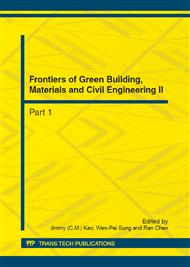p.211
p.216
p.221
p.227
p.231
p.235
p.239
p.243
p.248
Indoor Thermal Comfort Predicting Correlations in Subtropical Plateau Monsoon Climate
Abstract:
Fanger’s PMV is the most famous thermal sensation index but it is too complex to be applied in practice. Besides, the PMV index does not include the effect of hourly solar radiation on the indoor thermal climate. In order to obtain simple and applicable correlations with considerations of outdoor hourly solar radiation, a one-year measurement was performed in a naturally ventilated residential room in Qujing Normal University of Yunnan province, China. PMV indices are calculated by using Newton’s iterative method based on the collected data. Correlations of the PMV and the environmental parameters (outdoor air temperature, indoor air temperature, mean radiant temperature, wind velocity, relative humidity, hourly beam radiation and hourly diffuse radiation) have been developed by the multivariable regression technique. It is convenient to use them to predict the indoor thermal comfort in the subtropical plateau monsoon climate.
Info:
Periodical:
Pages:
231-234
Citation:
Online since:
August 2012
Authors:
Price:
Сopyright:
© 2012 Trans Tech Publications Ltd. All Rights Reserved
Share:
Citation:


